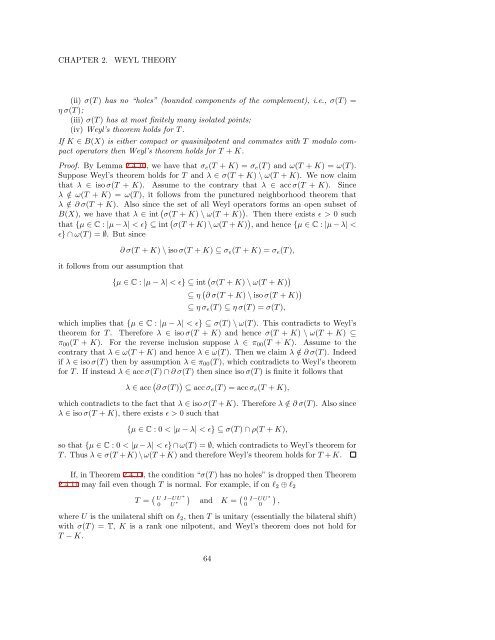Woo Young Lee Lecture Notes on Operator Theory
Woo Young Lee Lecture Notes on Operator Theory
Woo Young Lee Lecture Notes on Operator Theory
You also want an ePaper? Increase the reach of your titles
YUMPU automatically turns print PDFs into web optimized ePapers that Google loves.
CHAPTER 2.<br />
WEYL THEORY<br />
(ii) σ(T ) has no “holes” (bounded comp<strong>on</strong>ents of the complement), i.e., σ(T ) =<br />
η σ(T );<br />
(iii) σ(T ) has at most finitely many isolated points;<br />
(iv) Weyl’s theorem holds for T .<br />
If K ∈ B(X) is either compact or quasinilpotent and commutes with T modulo compact<br />
operators then Weyl’s theorem holds for T + K.<br />
Proof. By Lemma 2.4.10, we have that σ e (T + K) = σ e (T ) and ω(T + K) = ω(T ).<br />
Suppose Weyl’s theorem holds for T and λ ∈ σ(T + K) \ ω(T + K). We now claim<br />
that λ ∈ iso σ(T + K). Assume to the c<strong>on</strong>trary that λ ∈ acc σ(T + K). Since<br />
λ /∈ ω(T + K) = ω(T ), it follows from the punctured neighborhood theorem that<br />
λ /∈ ∂ σ(T + K). Also since the set of all Weyl operators forms an open subset of<br />
B(X), we have that λ ∈ int ( σ(T + K) \ ω(T + K) ) . Then there exists ϵ > 0 such<br />
that {µ ∈ C : |µ − λ| < ϵ} ⊆ int ( σ(T + K) \ ω(T + K) ) , and hence {µ ∈ C : |µ − λ| <<br />
ϵ} ∩ ω(T ) = ∅. But since<br />
∂ σ(T + K) \ iso σ(T + K) ⊆ σ e (T + K) = σ e (T ),<br />
it follows from our assumpti<strong>on</strong> that<br />
{µ ∈ C : |µ − λ| < ϵ} ⊆ int ( σ(T + K) \ ω(T + K) )<br />
⊆ η ( ∂ σ(T + K) \ iso σ(T + K) )<br />
⊆ η σ e (T ) ⊆ η σ(T ) = σ(T ),<br />
which implies that {µ ∈ C : |µ − λ| < ϵ} ⊆ σ(T ) \ ω(T ). This c<strong>on</strong>tradicts to Weyl’s<br />
theorem for T . Therefore λ ∈ iso σ(T + K) and hence σ(T + K) \ ω(T + K) ⊆<br />
π 00 (T + K). For the reverse inclusi<strong>on</strong> suppose λ ∈ π 00 (T + K). Assume to the<br />
c<strong>on</strong>trary that λ ∈ ω(T + K) and hence λ ∈ ω(T ). Then we claim λ /∈ ∂ σ(T ). Indeed<br />
if λ ∈ iso σ(T ) then by assumpti<strong>on</strong> λ ∈ π 00 (T ), which c<strong>on</strong>tradicts to Weyl’s theorem<br />
for T . If instead λ ∈ acc σ(T ) ∩ ∂ σ(T ) then since iso σ(T ) is finite it follows that<br />
λ ∈ acc ( ∂ σ(T ) ) ⊆ acc σ e (T ) = acc σ e (T + K),<br />
which c<strong>on</strong>tradicts to the fact that λ ∈ iso σ(T + K). Therefore λ /∈ ∂ σ(T ). Also since<br />
λ ∈ iso σ(T + K), there exists ϵ > 0 such that<br />
{µ ∈ C : 0 < |µ − λ| < ϵ} ⊆ σ(T ) ∩ ρ(T + K),<br />
so that {µ ∈ C : 0 < |µ − λ| < ϵ} ∩ ω(T ) = ∅, which c<strong>on</strong>tradicts to Weyl’s theorem for<br />
T . Thus λ ∈ σ(T + K) \ ω(T + K) and therefore Weyl’s theorem holds for T + K.<br />
If, in Theorem 2.4.11, the c<strong>on</strong>diti<strong>on</strong> “σ(T ) has no holes” is dropped then Theorem<br />
2.4.11 may fail even though T is normal. For example, if <strong>on</strong> l 2 ⊕ l 2<br />
T = ( )<br />
U I−UU ∗<br />
and K = ( )<br />
0 I−UU ∗<br />
0 U ∗ 0 0 ,<br />
where U is the unilateral shift <strong>on</strong> l 2 , then T is unitary (essentially the bilateral shift)<br />
with σ(T ) = T, K is a rank <strong>on</strong>e nilpotent, and Weyl’s theorem does not hold for<br />
T − K.<br />
64













